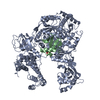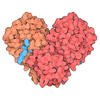+ Open data
Open data
- Basic information
Basic information
| Entry | Database: PDB / ID: 8fy1 | |||||||||||||||||||||
|---|---|---|---|---|---|---|---|---|---|---|---|---|---|---|---|---|---|---|---|---|---|---|
| Title | E3:PROTAC:target ternary complex structure (VCB/753b/BCL-2) | |||||||||||||||||||||
 Components Components |
| |||||||||||||||||||||
 Keywords Keywords | TRANSCRIPTION / ternary complex / degrader | |||||||||||||||||||||
| Function / homology |  Function and homology information Function and homology informationnegative regulation of cellular pH reduction / negative regulation of retinal cell programmed cell death / pigment granule organization / CD8-positive, alpha-beta T cell lineage commitment / BAD-BCL-2 complex / positive regulation of skeletal muscle fiber development / regulation of glycoprotein biosynthetic process / positive regulation of melanocyte differentiation / channel inhibitor activity / melanin metabolic process ...negative regulation of cellular pH reduction / negative regulation of retinal cell programmed cell death / pigment granule organization / CD8-positive, alpha-beta T cell lineage commitment / BAD-BCL-2 complex / positive regulation of skeletal muscle fiber development / regulation of glycoprotein biosynthetic process / positive regulation of melanocyte differentiation / channel inhibitor activity / melanin metabolic process / positive regulation of neuron maturation / myeloid cell apoptotic process / cochlear nucleus development / osteoblast proliferation / mesenchymal cell development / retinal cell programmed cell death / negative regulation of osteoblast proliferation / stem cell development / gland morphogenesis / renal system process / regulation of cell-matrix adhesion / The NLRP1 inflammasome / dendritic cell apoptotic process / ear development / negative regulation of calcium ion transport into cytosol / lymphoid progenitor cell differentiation / regulation of cellular response to hypoxia / melanocyte differentiation / T cell apoptotic process / negative regulation of myeloid cell apoptotic process / negative regulation of epithelial cell apoptotic process / BH3-only proteins associate with and inactivate anti-apoptotic BCL-2 members / regulation of nitrogen utilization / negative regulation of receptor signaling pathway via JAK-STAT / glomerulus development / RHOBTB3 ATPase cycle / negative regulation of dendritic cell apoptotic process / focal adhesion assembly / regulation of transmembrane transporter activity / negative regulation of T cell apoptotic process / oocyte development / B cell apoptotic process / metanephros development / neuron maturation / negative regulation of motor neuron apoptotic process / Regulation of MITF-M-dependent genes involved in apoptosis / positive regulation of multicellular organism growth / regulation of viral genome replication / transcription elongation factor activity / endoplasmic reticulum calcium ion homeostasis / target-directed miRNA degradation / elongin complex / regulation of mitochondrial membrane permeability / calcium ion transport into cytosol / negative regulation of ossification / Replication of the SARS-CoV-1 genome / response to UV-B / response to iron ion / negative regulation of mitochondrial depolarization / epithelial cell apoptotic process / axon regeneration / motor neuron apoptotic process / VCB complex / positive regulation of smooth muscle cell migration / smooth muscle cell migration / NFE2L2 regulating tumorigenic genes / intrinsic apoptotic signaling pathway in response to oxidative stress / Cul5-RING ubiquitin ligase complex / negative regulation of B cell apoptotic process / organ growth / hair follicle morphogenesis / branching involved in ureteric bud morphogenesis / intracellular membraneless organelle / Cul2-RING ubiquitin ligase complex / negative regulation of intrinsic apoptotic signaling pathway in response to DNA damage by p53 class mediator / B cell lineage commitment / digestive tract morphogenesis / negative regulation of G1/S transition of mitotic cell cycle / SUMOylation of ubiquitinylation proteins / pore complex / negative regulation of intrinsic apoptotic signaling pathway / T cell homeostasis / B cell homeostasis / BH3 domain binding / regulation of calcium ion transport / B cell proliferation / humoral immune response / negative regulation of anoikis / negative regulation of apoptotic signaling pathway / negative regulation of transcription elongation by RNA polymerase II / Pausing and recovery of Tat-mediated HIV elongation / Tat-mediated HIV elongation arrest and recovery / intrinsic apoptotic signaling pathway in response to endoplasmic reticulum stress / extrinsic apoptotic signaling pathway via death domain receptors / HIV elongation arrest and recovery / Pausing and recovery of HIV elongation / Estrogen-dependent nuclear events downstream of ESR-membrane signaling / Activation of BAD and translocation to mitochondria / hematopoietic stem cell differentiation / negative regulation of extrinsic apoptotic signaling pathway in absence of ligand Similarity search - Function | |||||||||||||||||||||
| Biological species |  Homo sapiens (human) Homo sapiens (human) | |||||||||||||||||||||
| Method |  X-RAY DIFFRACTION / X-RAY DIFFRACTION /  SYNCHROTRON / SYNCHROTRON /  MOLECULAR REPLACEMENT / Resolution: 2.56 Å MOLECULAR REPLACEMENT / Resolution: 2.56 Å | |||||||||||||||||||||
 Authors Authors | Nayak, D. / Lv, D. / Yuan, Y. / Zhang, P. / Hu, W. / Lv, Z. / Sung, P. / Hromas, R. / Zheng, G. / Zhou, D. / Olsen, S.K. | |||||||||||||||||||||
| Funding support |  United States, 6items United States, 6items
| |||||||||||||||||||||
 Citation Citation |  Journal: Nat Commun / Year: 2024 Journal: Nat Commun / Year: 2024Title: Development and crystal structures of a potent second-generation dual degrader of BCL-2 and BCL-xL. Authors: Nayak, D. / Lv, D. / Yuan, Y. / Zhang, P. / Hu, W. / Nayak, A. / Ruben, E.A. / Lv, Z. / Sung, P. / Hromas, R. / Zheng, G. / Zhou, D. / Olsen, S.K. | |||||||||||||||||||||
| History |
|
- Structure visualization
Structure visualization
| Structure viewer | Molecule:  Molmil Molmil Jmol/JSmol Jmol/JSmol |
|---|
- Downloads & links
Downloads & links
- Download
Download
| PDBx/mmCIF format |  8fy1.cif.gz 8fy1.cif.gz | 121.8 KB | Display |  PDBx/mmCIF format PDBx/mmCIF format |
|---|---|---|---|---|
| PDB format |  pdb8fy1.ent.gz pdb8fy1.ent.gz | 88.2 KB | Display |  PDB format PDB format |
| PDBx/mmJSON format |  8fy1.json.gz 8fy1.json.gz | Tree view |  PDBx/mmJSON format PDBx/mmJSON format | |
| Others |  Other downloads Other downloads |
-Validation report
| Summary document |  8fy1_validation.pdf.gz 8fy1_validation.pdf.gz | 677.9 KB | Display |  wwPDB validaton report wwPDB validaton report |
|---|---|---|---|---|
| Full document |  8fy1_full_validation.pdf.gz 8fy1_full_validation.pdf.gz | 684 KB | Display | |
| Data in XML |  8fy1_validation.xml.gz 8fy1_validation.xml.gz | 19 KB | Display | |
| Data in CIF |  8fy1_validation.cif.gz 8fy1_validation.cif.gz | 25.4 KB | Display | |
| Arichive directory |  https://data.pdbj.org/pub/pdb/validation_reports/fy/8fy1 https://data.pdbj.org/pub/pdb/validation_reports/fy/8fy1 ftp://data.pdbj.org/pub/pdb/validation_reports/fy/8fy1 ftp://data.pdbj.org/pub/pdb/validation_reports/fy/8fy1 | HTTPS FTP |
-Related structure data
| Related structure data |  8fy0C  8fy2C  6dc6S S: Starting model for refinement C: citing same article ( |
|---|---|
| Similar structure data | Similarity search - Function & homology  F&H Search F&H Search |
- Links
Links
- Assembly
Assembly
| Deposited unit | 
| ||||||||||||
|---|---|---|---|---|---|---|---|---|---|---|---|---|---|
| 1 |
| ||||||||||||
| Unit cell |
|
- Components
Components
| #1: Protein | Mass: 20729.531 Da / Num. of mol.: 1 Source method: isolated from a genetically manipulated source Source: (gene. exp.)  Homo sapiens (human) / Gene: VHL / Production host: Homo sapiens (human) / Gene: VHL / Production host:  |
|---|---|
| #2: Protein | Mass: 13147.781 Da / Num. of mol.: 1 Source method: isolated from a genetically manipulated source Source: (gene. exp.)  Homo sapiens (human) / Gene: ELOB, TCEB2 / Production host: Homo sapiens (human) / Gene: ELOB, TCEB2 / Production host:  |
| #3: Protein | Mass: 10843.420 Da / Num. of mol.: 1 Source method: isolated from a genetically manipulated source Source: (gene. exp.)  Homo sapiens (human) / Gene: ELOC, TCEB1 / Production host: Homo sapiens (human) / Gene: ELOC, TCEB1 / Production host:  |
| #4: Protein | Mass: 23005.842 Da / Num. of mol.: 1 Source method: isolated from a genetically manipulated source Source: (gene. exp.)  Homo sapiens (human) / Gene: BCL2 / Production host: Homo sapiens (human) / Gene: BCL2 / Production host:  |
| #5: Chemical | ChemComp-YF8 / Mass: 1640.478 Da / Num. of mol.: 1 / Source method: obtained synthetically / Formula: C82H104ClF3N11O11S4 / Feature type: SUBJECT OF INVESTIGATION |
| Has ligand of interest | Y |
-Experimental details
-Experiment
| Experiment | Method:  X-RAY DIFFRACTION / Number of used crystals: 1 X-RAY DIFFRACTION / Number of used crystals: 1 |
|---|
- Sample preparation
Sample preparation
| Crystal | Density Matthews: 2.67 Å3/Da / Density % sol: 53.92 % |
|---|---|
| Crystal grow | Temperature: 291 K / Method: vapor diffusion Details: 0.1 M Tris-Cl pH 8.7, 18% PEG 8000, 0.2 M MgCl2 and 3% 1,6-Hexanediol |
-Data collection
| Diffraction | Mean temperature: 108 K / Serial crystal experiment: N |
|---|---|
| Diffraction source | Source:  SYNCHROTRON / Site: SYNCHROTRON / Site:  APS APS  / Beamline: 24-ID-E / Wavelength: 0.979 Å / Beamline: 24-ID-E / Wavelength: 0.979 Å |
| Detector | Type: ADSC QUANTUM 315 / Detector: CCD / Date: Nov 29, 2020 |
| Radiation | Protocol: SINGLE WAVELENGTH / Monochromatic (M) / Laue (L): M / Scattering type: x-ray |
| Radiation wavelength | Wavelength: 0.979 Å / Relative weight: 1 |
| Reflection | Resolution: 2.56→94.6 Å / Num. obs: 22772 / % possible obs: 99.1 % / Redundancy: 6.9 % / Biso Wilson estimate: 55.35 Å2 / CC1/2: 0.99 / Net I/σ(I): 12.2 |
| Reflection shell | Resolution: 2.56→2.68 Å / Num. unique obs: 2722 / CC1/2: 0.8 |
- Processing
Processing
| Software |
| |||||||||||||||||||||||||||||||||||||||||||||||||||||||||||||||||||||||||||||||||||||||||||||||||||||||||
|---|---|---|---|---|---|---|---|---|---|---|---|---|---|---|---|---|---|---|---|---|---|---|---|---|---|---|---|---|---|---|---|---|---|---|---|---|---|---|---|---|---|---|---|---|---|---|---|---|---|---|---|---|---|---|---|---|---|---|---|---|---|---|---|---|---|---|---|---|---|---|---|---|---|---|---|---|---|---|---|---|---|---|---|---|---|---|---|---|---|---|---|---|---|---|---|---|---|---|---|---|---|---|---|---|---|---|
| Refinement | Method to determine structure:  MOLECULAR REPLACEMENT MOLECULAR REPLACEMENTStarting model: 6DC6 Resolution: 2.56→80.5 Å / SU ML: 0.3737 / Cross valid method: FREE R-VALUE / σ(F): 1.36 / Phase error: 30.2062 Stereochemistry target values: GeoStd + Monomer Library + CDL v1.2
| |||||||||||||||||||||||||||||||||||||||||||||||||||||||||||||||||||||||||||||||||||||||||||||||||||||||||
| Solvent computation | Shrinkage radii: 0.9 Å / VDW probe radii: 1.1 Å / Solvent model: FLAT BULK SOLVENT MODEL | |||||||||||||||||||||||||||||||||||||||||||||||||||||||||||||||||||||||||||||||||||||||||||||||||||||||||
| Displacement parameters | Biso mean: 66.25 Å2 | |||||||||||||||||||||||||||||||||||||||||||||||||||||||||||||||||||||||||||||||||||||||||||||||||||||||||
| Refinement step | Cycle: LAST / Resolution: 2.56→80.5 Å
| |||||||||||||||||||||||||||||||||||||||||||||||||||||||||||||||||||||||||||||||||||||||||||||||||||||||||
| Refine LS restraints |
| |||||||||||||||||||||||||||||||||||||||||||||||||||||||||||||||||||||||||||||||||||||||||||||||||||||||||
| LS refinement shell |
|
 Movie
Movie Controller
Controller



 PDBj
PDBj

















